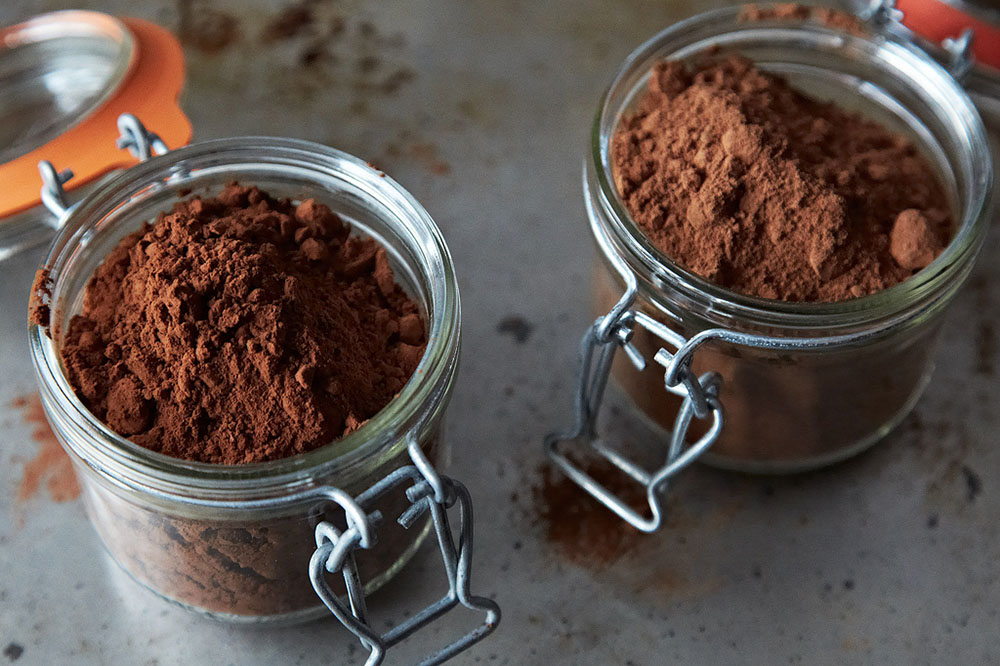
05 Oct What is Dutch Processing?
Dutch processing is a method that alkalize cacao beans with potassium or sodium carbonate –and that is one of the main reasons behind of the flat and slightly salty taste in processed cacao powder, as well as the chocolate made with these ingredients which is lowered to the level of candy. Dutch processing was developed in at 1828 by a Dutch chemist named Coenraad Van Houten and paved the way to mass produced chocolate. Mr. Van Houten is also responsible for another milestone processing method, which is the separation of the cacao bean into cacao butter and cacao powder (in this elaborate process the ground, melted cacao bean is pressed through a commercial press and split into cacao cake and cacao butter).
The reason behind all of this effort was a burning desire for creating a product with a high level of competition power. Because the chocolate was a liquid drink rather than a solid food until almost the mid 19th century in Europe, it was seen as a promising alternative to coffee with great potential. The unfortunate part of this drink though was that it was very hard to blend with water. Unlike coffee beans, roughly around 50% of a fermented cacao bean is a very healthy type of vegetable fat called cacao butter. The fat content of coffee beans, on the other hand, is around 10%). Cacao butter content of the whole bean was the culprit which was not allowing end users to blend the chocolate with water successfully. So Van Houten solved the problem by removing the fat – cacao butter from the whole ground bean.
Almost two century passed since this ingenious invention and chocolate become solid food plus not competing against coffee anymore… So why these two processing methods are still at the hearth of the modern, mass produced chocolate industry?
There are various reasons behind these applications. The number one reason is the effect of the alkali processing on the pH level of the authentic beans. The majority of mass production companies in contemporary chocolate industry increase the natural 4.5-5 pH level of cacao beans up to 8.5 to 9.5 pH level artificially with potassium or sodium carbonate. This process allows them to use too many beans of varying quality, combining okay beans together with bad, cheap, extremely acidic, bitter, and almost inedible beans to create a product with a relatively palatable flavor profile.
Alkalizing cacao beans is done through adding various chemical agents, (most commonly sodium carbonate dissolved in water) directly to the cacao powder, liquor, or cacao beans/nibs and then leaving it to rest in the solution. The mixture is then cooled and dried; leaving the alkali in/on whatever the form of cacao to which it has been applied. Duration, temperature, and intensity of the alkali are the key elements that determine the condition of the final product.
It is a well known fact that alkalizing cacao nibs or powders damages significantly the amount of the antioxidants as well as authentic flavor profile and personality of the cacao bean. In a way, it flattens the live cacao through killing all its colors and quirkiness and allows manufacturers to create chocolates as standard as McDonalds burgers. One of the very interesting articles on this subject can be found in The Journal of Agricultural and Food Chemistry 2008, 56 (here is a link for the full article: http://worldcocoafoundation.org/wp-content/files_mf/miller2008.pdf). As you will read in the article, alkalizing damages 60 to 90 % of antioxidants as well as the natural color and flavor of the beans.
I’m not quite sure what the law says in Canada (most companies do not say they are using dutch processing in their products) but in the United States, food labeling requires that alkalized (dutched) cocoa powders or liquors be declared as “cocoa [liquor] treated with alkali”. Labeling requirements are vary according to countries, thus making it pretty hard for consumers to figure out whether natural or alkalized cocoa is used in the chocolate that they are buying. None the less here are some tips for you to use to figure out if the chocolate you are buying is dutch processed or not:
- The natural color of cacao is between light brown to slightly darker, reddish brown – more in the milk chocolate range. So a chocolate made out of undutched beans would be lighter in color and way more fragrant and multi dimensional in flavor if it is made out of fine flavor heirloom beans; While the dutch processed ones would be extremely dark brown to black in color and very much one dimensional in the mouth because they are dmaged and denaturated through dutching process.
In Summary:
Dutching improves the cacao powder’s bonding ability with water or other foreign fats rather than increasing its solubility in warm water. The most visible effect of dutch processing occurs in the flavor and the color of the resultant cacao powder or chocolate. It makes the color extremely dark brown to black and also it kills almost every detail together with most of the antioxidants (up to 90%) in the original flavor profile of the bean.
In 1828, the hundreds of years old thick, foamy medicinal, ceremonial drink called “chocolate” was dethroned successfully by “instant cocoa drink” idea of Mr. Van Houten. Since then his invention of defattening and alkalizing the cacao, opened the door to large scale manufacturing of cheap chocolate for the masses and changed the history of chocolate making in fundamental level..
P/S Please let us know if you have any questions or anything you wanted to add to this topic.
Paul Dincer,
Owner and Founder of Koko Monk Chocolates, Vancouver


